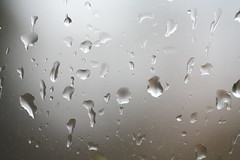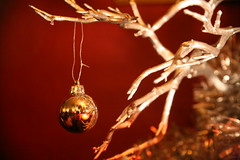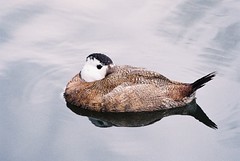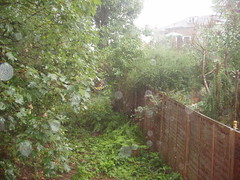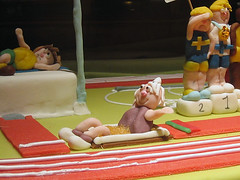I met Guido in the hotel lobby. He is a friend of the hotel owner and is an independant jungle tour organiser. He had a red eye from having riden his motorcycle too close to a lorry on a gravel road. I wasn't too sure about booking a jungle tour with him as the Lonely Planet guide had warned against using independant services as they vary greatly in quality. But Guido had been recommended by the hotel and his price was quite cheap for a few days in a small jungle village, hosted in the guide's house. So I decided to take the offer. We would meet on the following day, Wednesday, at 4pm to cach a boat that was leaving at 5.
I checked out Wednesday afternoon, left my big bag at the hotel, hoping to come back on the Saturday afternoon, and kept my small day bag with a few changes of clothes, the camera and some basic toilettries. I still wasn't sure whether I'd see Guido or if he would disappear with my money but he was here, 10 minutes before time. We took a motocarro, the equivalent of the Indian tuk-tuk, to the harbour and boarded the boat where Guido had already set up two hammocks and loaded enough food and water for 4 days. This wasn't a private boat, it was the standard public transport barge that locals take when they want to go somewhere. There is no road here, the river is the road. Hopefully it wasn't too crowded so we had space to breathe. We had one hour before departure, during which a crowd of street sellers passed from person to person selling everything from batteries to full meals, via peanuts, hammocks, fizzy drinks, etc. The boat had to do a fairly complicated manoeuvre to extract itself from its part of the harbour but we were finally on our way. It wasn't the Amazon yet, it was a small affluent
that was wider than the Thames, even though it was the dry season. We got to the Amazon itself a few minutes later, where the waters changed from a dark brown to a milky brown: cafe solo, cafe con leche
. Now we just had to wait and enjoy the sunset.
We got to our destination in the middle of the night. The barge stopped along the river bank just a few minutes to let us disembark. No quay here, just mud. A friend of Guido was waiting to help us carry our stuff. A few hundred metres along the bank and over a small wooden bridge took us to the house where we would spend the night. After installing mattresses and mosquito nets on the beds, we could finish the night.
The following day started early. I was introduced to Enrique, whose house it was and who was to be my guide for the next few days. So after breakfast, we set off for the jungle around the village. I didn't wait long to see my first jungle animal: one of the village guys had a very tired anaconda in his wash basin just outside his house. We did quite a long walk through the forest, with Enrique explaining the usage of different plants and trees, showing me some notable species like the sequoia which the locals are not allowed to cut as they are in a protected reserve. We also spotted quite a few birds and even a paca, a big rodent like an outsized beaver without the tail. We stopped at Enrique's papaya field for a papaya and to retrieve his fishing equipment. Among the papaya were some remnants of banana trees. Tree is not the right word. Inside, it looks more like a huge leek than a tree. We then stopped at a small river where we set about fishing piranha. We had the visit of a big hawk but no piranhas. They would eat the bait and go away too quickly for us to actually catch any of them. So we decided to go back to the house for lunch. On the way back, we met Enrique's wife in a panic: her father had been bitten by a venomous snake the day before, while deep in the jungle, and was being brought to the house. He needed immediate treatment but nobody had a vaccine, they were too poor to have health services and anyway it would have to come from too far away. The only solution was the local shaman who knew how to deal with a snake bite using local plants. I felt completely inadequate. In hindsight, knowing I was going to the jungle, I should have carried a vaccine with me but I didn't. The only contribution I could make that day was translate the English manual of the emergency suction based venom extraction kit but even that was useless as it needs to be used a few minutes after the bite, not the day after. The old man was in excruciating pain. There was nothing we could do but let the local healer work so, after having luch, Enrique took me for a boat trip on the river to go see some dolphins. The Amazon has two species of fresh water dolphins, a grey one and a pink one. Of course the ones all tourists want to see are the pink ones but we only saw a few greay ones, as well as quite a few birds: cormorans, herons, etc. Back at the house, the shaman was at work and his remedy seemed to work, as the pain in the old man's leg was easing. We finished the day with a game of volleyball on the communal ground, during which I showed how crap I am at this game.
We got up early on the Friday. Enrique's father in law had had a quiet night, the venom cure seemed to have worked very well. Enrique, Guido and I were to go on a canoo trip on some of the small rivers deeper in the jungle and Enrique would take me to the real jungle, not the semi wild thing around the village. While making our way up river, we saw a lot of birds again and a few bats that were spending the day asleep under tree branches. We got to the small house of a friend of Enrique, where Guido would prepare lunch while we would go into the forest.
The jungle in that part was very thick and we had to cut our way through some of it with a machete. Or rather, Enrique did the cutting, I did the following trying not to trip over. There was a lot to see, especially more of the huge sequoia trees and more birds and insects, in particular the huge electric blue Morpho butterfly, that is considered by locals an evil spirit that leads people deep in the forest for them never to return. Then suddenly Enrique turns round, stops and tells me to move slowly. Just there, spiralling around a dangling branch is a bright green bushmaster snake, the largest venomous snake in this part of the world. It is more than two metre long and doesn't move at all while we circle it. It is absolutely beautiful but also deadly. After this adrenalin rush, we slowly head back towards the river, the house and lunch. After lunch, we canoo back down the river and stop for some more piranha fishing. We manage to catch two, a red one and a white one, where I learn there are different species of piranha, but they are both too small and we have to let them go. Not before Enrique shows me how they can cut a leaf in pieces with their teeth though.
Back at Enrique's house, we decide to wash the grime of the day in the big river. It is not the Amazon anymore here, we are too far upriver, it is one of the two rivers that become the Amazon at Nauta. While having a swim within easy reach of the bank, I ask Enrique what fish live in the river. Piranhas; caneros, a fish that smells human urine and attacks you so don't piss in the river; caimans; dolphins; electric eels that can kill a man; and all sorts of other inoffensive creatures.
Just on cue, I feel small teeth gnawing at my leg. It is a small fish of the inoffensive sort that thought it would have a go at this big pink thing. We are in water that is too shallow for the more offensive residents. After diner and a quick game of cards with Enrique's young children and brother in law, I decide to go to bed early as the following day's plan is to get up at first light, take a boat to Nauta to see where the Amazon starts and then a bus back to Iquitos. Indeed, Iquitos can now be reached by road from Nauta. The road has been open a few months and has cost the Peruvian government a huge amount of cash as it goes straight through the jungle but it makes communication much easier.
Suddenly, a couple of hours after dark, Enrique's father in law, who had been feeling well all day, starts crying in pain. The pain of the venom is not in the leg anymore, it is in the stomach. His family assemble around him, pray, cry, try the shaman's remedy that had worked so well and everything they can think of, to no avail. The old man dies an hour later in excruciating pain. There has been no time to call any doctor or shaman. As is the custom here, the mourning starts with the wailing, taken to histerical levels. And because he was the oldest man in the village, it will happen in the communal house. Guido and I feel completely out of place. We decide to go immediately and leave the family and village to privately mourn the old man. The barge is meant to stop here at 10pm to load more than 800 bags of rice, the surplus production of the village that is one of their main source of incoming cash.
We arrived back in Iquitos at 9am this morning. I checked back at the hotel and had a shower. Guido and I will meet later on for lunch. Then tonight I will meet other people I met on Tuesday, when I arrived, so that they can show me the night life of Iquitos. The feeling is very strange though.
